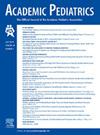医疗复杂性儿童口腔健康的差异。
IF 2.8
3区 医学
Q1 PEDIATRICS
引用次数: 0
摘要
目标:有医疗复杂性的儿童(CMC)是有特殊健康护理需求的儿童(CSHCN)中的一个子群体,他们有最严重的医疗状况和残疾,有因口腔健康不良而受到负面影响的风险。CSHCN 的口腔健康不良率很高,包括龋齿。本研究旨在比较儿童医护人员(CMC)和儿童保健工作者(CSHCN)的口腔健康状况:这是对 2016-17 年全国儿童健康调查数据的横断面分析。使用经过验证的算法确定了 CMC 和 CSHCN。主要结果是口腔健康状况;次要结果包括牙科服务使用情况。双变量分析比较了医疗复杂性状况的患病率和服务使用情况。多变量逻辑回归根据复杂性评估口腔健康结果,并对影响变量进行调整:在 16178 名 1-17 岁的 CSHCN 中,6% 为 CMC,94% 为非 CMC CSHCN。结论:尽管接受预防性牙科服务的比例很高,但每五名儿童保健工作者中就有一人口腔健康状况较差,包括龋齿。在对社会经济因素进行调整后,医疗复杂性仍与牙齿状况一般或较差有关。了解潜在的可改变目标可以进一步帮助 CMC 家庭优先考虑牙科需求,并有可能减少对整体健康的负面影响。本文章由计算机程序翻译,如有差异,请以英文原文为准。
Differences in the Oral Health of Children With Medical Complexity
Objective
Children with medical complexity (CMC), a subgroup of children with special health care needs (CSHCN) with the most serious medical conditions and disabilities, are at risk for negative effects from poor oral health. CSHCN have high rates of poor oral health, including cavities. This study aimed to compare oral health status between CMC and CSHCN.
Methods
This was a cross-sectional analysis of the 2016–17 National Survey of Child Health data. CMC and CSHCN were identified using validated algorithms. The primary outcome was oral health status; secondary outcomes included dental service use. Bivariate analyses compared the prevalence and service use by medical complexity status. Multivariable logistic regression assessed oral health outcomes by complexity, adjusting for influencing variables.
Results
Of 16,178 CSHCN ages 1 to 17 years, 6% were CMC and 94% were non-CMC CSHCN. Compared to CSHCN, CMC had a higher prevalence of fair/poor teeth conditions (19% vs 9%; P < 0.001) and higher odds for fair/poor teeth conditions after adjusting for socioeconomic factors (adjusted odds ratio [aOR]: 1.54; 95% confidence interval [CI]: 1.01–2.34). There was no statistically significant difference between groups when assessing cavities, toothache, or receipt of most preventive dental services.
Conclusions
One in 5 CMC are reported by caregivers as having poor oral health, including cavities, despite high rates of receiving preventive dental services. After adjusting for socioeconomic factors, medical complexity remained associated with fair or poor teeth conditions. Understanding potentially modifiable targets could further help families of CMC prioritize dental needs and potentially reduce negative effects on overall health.
求助全文
通过发布文献求助,成功后即可免费获取论文全文。
去求助
来源期刊

Academic Pediatrics
PEDIATRICS-
CiteScore
4.60
自引率
12.90%
发文量
300
审稿时长
60 days
期刊介绍:
Academic Pediatrics, the official journal of the Academic Pediatric Association, is a peer-reviewed publication whose purpose is to strengthen the research and educational base of academic general pediatrics. The journal provides leadership in pediatric education, research, patient care and advocacy. Content areas include pediatric education, emergency medicine, injury, abuse, behavioral pediatrics, holistic medicine, child health services and health policy,and the environment. The journal provides an active forum for the presentation of pediatric educational research in diverse settings, involving medical students, residents, fellows, and practicing professionals. The journal also emphasizes important research relating to the quality of child health care, health care policy, and the organization of child health services. It also includes systematic reviews of primary care interventions and important methodologic papers to aid research in child health and education.
 求助内容:
求助内容: 应助结果提醒方式:
应助结果提醒方式:


